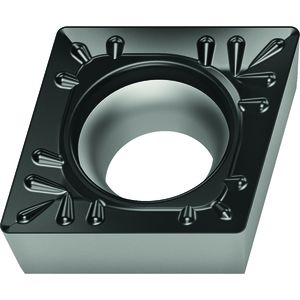Brief explanation of what turning inserts are in the context of metalworking.
Importance of turning inserts in precision machining and manufacturing.
1. Understanding Turning Inserts
Definition and Functionality
- Explanation of what turning inserts are and how they are used in machining.
- Types of materials used for turning inserts (e.g., carbide, ceramics, CBN).

Turning inserts are specialized cutting tools used in machining processes, specifically in turning operations. Turning is a common metalworking process in which a workpiece rotates while a cutting tool removes material to create cylindrical or conical shapes. Turning inserts are typically made of hard materials like carbide, ceramic, or cubic boron nitride (CBN), which provide high wear resistance and toughness.
These inserts are designed with various geometries and cutting edge configurations to suit different machining applications and materials. They are mounted onto the tool holder or tool post of a lathe or turning machine. The cutting edges of the insert come into contact with the workpiece as it rotates, generating chips and precisely shaping the material.
Turning inserts offer several advantages in machining. They allow for efficient and accurate metal removal, reducing production time and costs. The ability to replace and index inserts without changing the entire tool setup enhances productivity. Moreover, the selection of appropriate insert types and grades enables machinists to optimize cutting speed, feed rate, and depth of cut for specific materials, resulting in improved surface finish and dimensional accuracy of the machined components.
Turning inserts are manufactured using a variety of cutting-edge materials, each tailored to specific machining requirements. One common material is carbide, known for its exceptional hardness, heat resistance, and durability. Carbide inserts are suitable for a wide range of applications, from general-purpose machining to high-speed and heavy-duty cutting. Another material option is ceramics, which offer excellent thermal stability and chemical resistance. Ceramics inserts are often chosen for high-speed machining of hardened steels and cast irons. For machining hard and abrasive materials, cubic boron nitride (CBN) inserts are preferred due to their exceptional hardness and thermal conductivity. CBN inserts excel in machining ferrous materials like hardened steels and cast iron, delivering extended tool life and improved surface finishes. The choice of turning insert material depends on factors such as the workpiece material, cutting conditions, and desired machining outcomes, allowing manufacturers to optimize performance and productivity in various machining operations.
Types of Turning Inserts
- Overview of different geometries and shapes of turning inserts (e.g., ISO, ANSI).
- Different grades of turning inserts and their applications (e.g., general purpose, high-speed cutting).
Firstly, the overview of different geometries and shapes of turning inserts, such as ISO and ANSI standards, is essential. The ISO standard defines insert geometries with standardized codes, facilitating international compatibility. These geometries encompass variations like square, triangular, rhombic, and round, each serving distinct cutting purposes. On the other hand, the ANSI standard primarily focuses on triangular inserts and their derivatives, commonly used in North America. This array of geometries allows machinists to select the most suitable insert shape for a particular task, optimizing chip control, tool life, and surface finish.
Moving on to the second aspect, the diverse grades of turning inserts and their applications play a crucial role in achieving efficient machining outcomes. General-purpose grades, with balanced properties of hardness and toughness, find utility in a wide array of materials and cutting conditions. They are ideal for routine turning operations. Conversely, high-speed cutting grades exhibit enhanced heat resistance and wear characteristics, making them ideal for operations involving elevated cutting speeds and heat generation. These grades minimize tool wear and extend tool life. Moreover, specialized grades designed for specific materials, like stainless steels or superalloys, offer tailored solutions for challenging machining scenarios. By carefully selecting the appropriate insert grade based on material type, cutting parameters, and desired results, manufacturers can optimize productivity and precision in their turning processes.
2. Benefits and Advantages
Improved Efficiency and Productivity
- How turning inserts enhance machining efficiency and reduce cycle times.
- Examples of industries that benefit from using turning inserts.
Turning inserts play a pivotal role in elevating machining efficiency and reducing cycle times, thereby contributing to enhanced productivity in various industries. Firstly, these inserts are engineered with precision geometries and cutting-edge materials that facilitate high-speed and precision cutting. The advanced chip breaker designs effectively manage chip flow, reducing interruptions and minimizing downtime for chip evacuation. This seamless chip control leads to uninterrupted machining processes, ultimately reducing cycle times and boosting productivity. Additionally, turning inserts with optimized coatings and wear-resistant properties significantly extend tool life, reducing the need for frequent tool changes. This prolonged tool life directly translates into reduced setup times and increased machine utilization.
Turning inserts find application across a wide spectrum of industries, exemplifying their versatility and impact on efficiency. In the automotive sector, for instance, these inserts are utilized in the production of engine components, transmission parts, and brake systems. Their ability to maintain tight tolerances and deliver smooth surface finishes enhances overall product quality. Aerospace industries also reap the benefits of turning inserts when manufacturing precision components like turbine blades, landing gear components, and aerospace alloys. The inserts’ capacity for high-speed cutting and material-specific grades ensures efficient machining of intricate parts. Furthermore, the medical industry leverages turning inserts in the fabrication of surgical instruments, implants, and medical devices. The inserts’ accuracy and consistency contribute to the production of intricate designs and complex shapes essential in medical applications. Across these diverse sectors and beyond, turning inserts stand as a testament to their role in elevating machining efficiency and propelling industrial productivity forward.
Surface Finish and Precision
- How turning inserts contribute to achieving high-quality surface finishes.
- Importance of precise insert geometry for dimensional accuracy.
The precisely engineered geometries of turning inserts ensure consistent and controlled material removal during machining. The sharp cutting edges and well-designed chip breakers effectively manage chip formation and evacuation, preventing built-up edge and reducing the likelihood of surface imperfections. This level of control over chip flow and tool engagement translates into smoother cutting actions, resulting in improved surface finish. Additionally, the selection of appropriate insert coatings enhances lubricity and heat resistance, further promoting a superior surface finish by minimizing friction and heat-related issues.
The importance of precise insert geometry cannot be understated in maintaining dimensional accuracy. The accurate shape and dimensions of turning inserts directly influence the final dimensions of the machined workpiece. Even the slightest deviation in insert geometry can lead to variations in part dimensions, affecting the overall quality and functionality of the component. A well-defined and consistent insert geometry ensures that each pass of the cutting tool removes the intended amount of material, minimizing errors and achieving the desired tolerances. This precision in insert geometry, combined with the cutting tool’s stability and rigidity, guarantees the repeatability and reproducibility required for tight tolerances and precise workpiece dimensions.
For the reasons above, turning inserts not only contribute to impeccable surface finishes through controlled chip flow and optimized coatings but also ensure the utmost accuracy in dimensional control through their meticulously engineered geometries. This dual impact on surface quality and dimensional accuracy underscores the critical role that turning inserts play in delivering high-performance machining results across various industries.
Cost Savings and Tool Life
- Discussion on how turning inserts can lead to longer tool life and reduced tool changeovers.
- Factors influencing tool life, including coatings and cutting parameters.
Turning inserts are crafted from advanced materials such as carbide, ceramics, and CBN, chosen for their remarkable hardness and resistance to wear. These materials can withstand the abrasive forces and high temperatures generated during machining, ensuring prolonged tool life even under demanding conditions. This durability translates into fewer instances of tool replacements, reducing interruptions in the machining process and enhancing overall efficiency.
In addition to material selection, coatings applied to turning inserts play a pivotal role in enhancing tool life. These specialized coatings, often composed of layers of carbides, nitrides, and other advanced materials, provide increased lubricity, heat resistance, and chemical stability. The coatings reduce friction and heat generation at the cutting edge, preventing tool wear and extending the insert’s operational life. As a result, the combination of robust materials and effective coatings synergistically contributes to longer-lasting turning inserts.
The optimization of cutting parameters significantly influences tool life. Machining conditions such as cutting speed, feed rate, and depth of cut should be meticulously adjusted based on the workpiece material and application. Properly chosen cutting parameters prevent excessive tool wear, heat buildup, and vibrations, which can prematurely deteriorate the insert. Through careful consideration and adjustment of these parameters, machinists can ensure that turning inserts operate within their optimal performance range, leading to extended tool life and reduced need for tool changeovers.
3. Selecting the Right Turning Inserts
Factors to Consider
- Material being machined (e.g., steel, aluminum, exotic alloys).
- Cutting conditions and machine parameters.
- Desired surface finish and tolerances.
Insert Geometry and Grades
- In-depth explanation of various insert geometries and their effects on machining.
- Matching insert grades to specific machining applications.
4. Proper Application Techniques
Cutting Speeds and Feeds
- Guidelines for selecting appropriate cutting speeds and feed rates.
- Calculating cutting parameters based on workpiece material and insert type.
Insert Installation and Alignment
- Step-by-step instructions for correctly installing and aligning turning inserts.
- Importance of secure insert clamping for stability and precision.
5. Troubleshooting and Maintenance
Common Machining Issues
- Identification and solutions for issues like chatter, built-up edge, and poor surface finish.
- How to adjust cutting parameters to address specific problems.
Maintenance Practices
- Proper cleaning and handling of turning inserts to prolong their lifespan.
- Storage recommendations to prevent damage and oxidation.
6. Future Trends and Innovations
Advancements in Insert Materials
- Overview of emerging materials for turning inserts and their potential benefits.
- Impact of nanotechnology and coatings on insert performance.
Industry 4.0 Integration
- Discussion on how digitalization and data-driven approaches are shaping the future of turning inserts.
- Integration of AI and machine learning for optimizing machining processes.
- Recap of the key points discussed in the guide.
- Emphasis on the importance of selecting the right turning inserts for efficient and precise metalworking.
It will be a comprehensive guide that covers everything they need to know about turning inserts in metalworking. Each section addresses specific aspects, such as understanding turning inserts, their benefits, selection criteria, application techniques, troubleshooting, and future trends. This approach ensures that readers gain both theoretical knowledge and practical insights, making the article a valuable resource for those seeking information on this topic.


